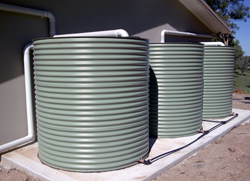 How To Construct Your Water Tank Base
How To Construct Your Water Tank Base
This brief guide for base preparation should be followed to ensure a correct foundation is laid for your water tank. Damage to your rainwater tank due to failure or movement of the tank base is not covered by the warranty. Please keep in mind that 1000L of water weighs 1000kg, and this is a significant force. Soft ground may subside under the weight of a full tank.
The base of your water tank is made with double sided Aquaplate® i.e. the inside and outside of the water tank base is coated with a polymer film to prevent corrosion. The water tank may be in direct contact with the base and the tank will not corrode. Hence there is no reason to elevate the water tank above ground level.
This base preparation guide should be taken as a guide only.
 A concrete slab base is the most suitable base for your rainwater tank. Construction of a concrete base needs a minimum of 100mm thick concrete and F62 mesh, on a flat level area. If the water tank is to be positioned in an area that is on a slope then the thickness of the slab is to be increased and the mesh to be a higher grade. The slab must be flat, smooth and level. Finish with a metal trowel is advisable.
A concrete slab base is the most suitable base for your rainwater tank. Construction of a concrete base needs a minimum of 100mm thick concrete and F62 mesh, on a flat level area. If the water tank is to be positioned in an area that is on a slope then the thickness of the slab is to be increased and the mesh to be a higher grade. The slab must be flat, smooth and level. Finish with a metal trowel is advisable.
Slabs must be large enough to support all edges of the tank, and should be at least 100mm longer and wider than the tank.
 To use a concrete paver base, the area must be cleared down to firm earth. A paver base installed on soft ground (i.e. a garden bed) will subside over time, and is not advisable. Once dug down to a firm surface, spread sand and cement mix 75mm thick over the entire base, level out then proceed to place concrete pavers flat on top. Once laid, shower the pavers with water to set the sand and cement off. Paver base is to be large enough to support all edges of the rainwater tank. The water tank may be placed on to paver base straight away. Do not fill the water tank above 2 corrugations for at least 48 hours.
To use a concrete paver base, the area must be cleared down to firm earth. A paver base installed on soft ground (i.e. a garden bed) will subside over time, and is not advisable. Once dug down to a firm surface, spread sand and cement mix 75mm thick over the entire base, level out then proceed to place concrete pavers flat on top. Once laid, shower the pavers with water to set the sand and cement off. Paver base is to be large enough to support all edges of the rainwater tank. The water tank may be placed on to paver base straight away. Do not fill the water tank above 2 corrugations for at least 48 hours.
 A crusher dust base is considerably cheaper than a concrete slab, but may need to be augmented over time. Heavy rainfalls can erode a crusher dust base and may cost you extra if it needs to be repaired.
A crusher dust base is considerably cheaper than a concrete slab, but may need to be augmented over time. Heavy rainfalls can erode a crusher dust base and may cost you extra if it needs to be repaired.
Crusher dust is available from any landscape material suppliers.
Crusher dust bases are only suitable for larger diameter round water tanks. The crusher dust must have no particles larger than 5mm diameter. The crusher dust is to be 100mm thick. It must be compacted, level and flat. A border must be placed around the crusher dust to ensure it does not erode over time or is undermined by heavy rain or burrowing animals. You can use 100mm treated pine railings, screwed together at the ends to retain the crusher dust but many other materials are appropriate.The base should be large enough to support all edges of the water tank. The rainwater tank may be filled straight away. Coarse aggregate should be spread over any exposed crusher dust, after the tank is positioned, to prevent erosion.
Note: Care must be taken when positioning the rainwater tank on a crusher dust base to ensure it does not dig in and create an uneven surface.
Gardeners Watertanks Brisbane can construct any of these bases for you, if you live in the greater Brisbane area. Please contact us if you require any assistance.
